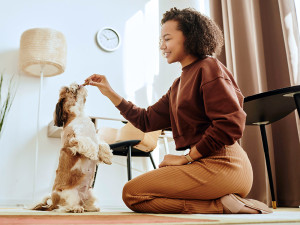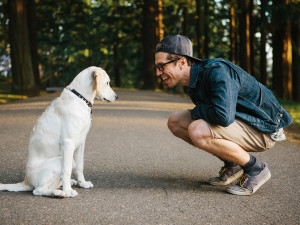9 Myths About Your Puppy—Busted By a Behaviorist
The internet has a lot to tell you about your new addition. Here’s what’s actually true.

share article

Your pet wants you to read our newsletter. (Then give them a treat.)
Dispelling myths about raising and training puppies helps change patterns of behavior that are detrimental to the goal of raising happy, healthy, well-behaved, and well-adjusted puppies. That in turn can make it easier for puppies to adapt to their new home in a way that sets up people and dogs alike for a full dog’s lifetime of love and happy relationships. Let’s debunk nine common myths so you and your puppy can start your life together on the right paw (sorry, had to).
Myth 1: Puppies can’t be around other dogs at all until they are fully vaccinated.
Yes, they can, and they should. If you wait until a puppy is fully vaccinatedopens in a new tab to introduce them to other dogs, it will be too late for them to develop the normal canine social skills and the comfort of being around other dogs that naturally occur when they meet other dogs early on.
Puppies need to meet other dogs in the range of eight to 14 weeks old and then keep meeting new ones regularly as they are developing into adults. However, most puppies aren’t fully vaccinatedopens in a new tab until they are 16 to 18 weeks old, so if you wait until then, your puppy will be beyond the window when exposure to other dogs does the most good for their development.
Myth 2: If you comfort them, you’ll reinforce their fear.
No, you won’t. Behavior can be reinforced, not emotions. Giving solace to a fearful puppy is both kind and helpful. When they are afraid, whether it’s because of thunder, a charging cat, the giant box in the entryway, or anything else in their world, they need you. Your reassurance and loving manner help them feel more secure and more confident.
You offer them feelings of safety when you comfort them. To deprive them of this because of the concern that you might make them more fearful is an idea without merit, so thankfully you can follow the natural impulse to sooth them.
Myth 3: It’s good to take your puppy running for exercise.
No, it’s not. Many dogs grow up to be great running partnersopens in a new tab, but puppies should not go running with us. Sustained running is not good for young dogs, especially if they are running on concrete, asphalt, or other hard surfaces. That can be damaging to feet, joints, and other parts of the body.
Puppies can run around and play, but that is different than going running for an extended time. The age at which dogs can start to run varies based on many factors, including the size of the dog and type of the dog. A common recommendation is not to run with your dog until they are at least nine months to a year old, but it’s essential to consult with your veterinarian for advice about your particular dog.
Myth 4: Puppies who live with other dogs know how to get along with dogs and don’t need play dates or other opportunities to meet dogs.
Yes, they do. Even though the other household dogsopens in a new tab are a part of teaching a puppy to be dog- social, it’s not sufficient just to know the other dogs they live with.
Dogs who only know the few dogs in their family are likely to be comfortable with those dogs only and not with other dogs. In order to be comfortable with a variety of dogs they know and don’t know, they need multiple experiences meeting unfamiliar dogs. That way they learn to be comfortable with dogs in general and not just with a few dogs specifically.
Myth 5: Puppies need walks starting when you bring them home.
No, they don’t. Puppies need exercise, mental stimulation, and attention, which are commonly available on walks, but walks are not the only way to provide them. Many puppies feel overwhelmed by walks and do better with time outside in the yard, play sessions, and food puzzles opens in a new tabto accomplish the same things that walks do.
If your puppy seems to enjoy walks, that’s great and you should absolutely walk them. However, if your puppy needs a little time to adjust before starting a walking routine, it’s also totally fine to ease into walks by using a leash and collar in the house or in the yard or by meandering just one or two houses down the block and then returning home.
Myth 6: Puppies must meet hundreds of people in the first two months you have them.
Socialization is the process of exposing a puppyopens in a new tab to a variety of new experiences during the critical period of their lives from three to 14 weeks. The high quality of these experiences is important in a way that high quantity isn’t. What is essential is that your puppy has positive experiences with the people they meet.
That means you want people to be calm with them and to offer them treats, play, or petting if they enjoy that physical contact. A handful of experiences that are positive and enjoyable for the puppy are far better for socialization purposes than a large number that the puppy finds overwhelming, scary, confusing, or otherwise unpleasant.
Myth 7: Puppies should go to the dog park for socialization.
No, they shouldn’t. Yes, dogs need to meet other dogs during their socialization period in order to be comfortable around other dogs, including when they are meeting new ones, for the rest of their lives. But the dog park is not the placeopens in a new tab to do this. Puppies need to meet dogs one at a time, or in small groups, and these dogs they meet should be carefully chosen.
A puppy should meet other puppies and nice adult dogs with good social skills so the puppies have a positive experience and learn proper dog social skills. At the dog park, they are likely to become overwhelmed by too many dogs, high arousal dogs, rude dogs, or even aggressive dogs. Taking a puppy to the dog park is far more likely to teach young dogs that other dogs are to be feared than that other dogs make good friends. Also, there is too high a risk of contact with germs at the dog park that can cause serious diseases in puppies.
Myth 8: Crate training is mean.
No, it’s not. Teaching your puppy to be comfortable in a crate is kind. Many dogs love their crates opens in a new taband feel comfortable in them no matter where they are. A dog who has been crate trainedopens in a new tab will likely feel more comfortable and relaxed when they travel, go to someone else’s house, or must be at the vet or the groomer for longer than just a brief visit. Otherwise, these experiences can be more stressful. Crates should not be used for extended periods of time and certainly not as punishment.
Myth 9: Puppies and collar/leashes are a natural combo.
No, they aren’t, though I so wish they were. Most dogs must be taught to accept collarsopens in a new tab and leashes or they will scratch at them or try to shake them off and get away from them. If you start when a puppy is young — two months old or so — by putting a collar on and then later attaching a leash to it, they have an easier time accepting them than if you start when they are significantly older.
To make it easier and more comfortable for them to get used to a leash, start with lightweight versionsopens in a new tab of both (even possibly a cat leashopens in a new tab for small or sensitive pups!) and make sure the collar is not so tight it causes discomfort but not so loose it moves a lot or can be slipped out of. Associate the collar and leash with treats and fun. Always do something they like, such as offer them treats or go outside to walk or play after you put on the collar and leash.
References:
You Can’t Reinforce Fear; Dogs and Thunderstormsopens in a new tab

Karen B. London, PhD, CAAB, CPDT-KA
Karen B. London, Ph.D., is a Certified Applied Animal Behaviorist and Certified Professional Dog Trainer who specializes in working with dogs with serious behavioral issues, including aggression, and has also trained other animals including cats, birds, snakes, and insects. She writes the animal column for the Arizona Daily Sun and is an Adjunct Professor in the Department of Biological Sciences at Northern Arizona University. She is the author of six books about training and behavior, including her most recent, Treat Everyone Like a Dog: How a Dog Trainer’s World View Can Improve Your Lifeopens in a new tab.
Related articles
![A dog at a shelter looking up at the camera.]() opens in a new tab
opens in a new tab10 Questions to Ask a Shelter About an Adoptable Dog
From exercise needs to medical history to compatibility with kids, here is everything you need to know.
![A woman staring at her computer while holding her dog close.]() opens in a new tab
opens in a new tab10 Things to Consider Before Adopting a Pet
It’s a big decision, so check these boxes before you sign on the dotted line.
![man and lab puppy on park road]() opens in a new tab
opens in a new tabWhen, Exactly, Should You Vaccinate Your Puppy?
If it’s time for a round of shots (no, not that kind), follow this guide.
![Afghan hound dog mid jump in an open grass field]() opens in a new tab
opens in a new tabOverexcited Dog? How to Calm A Dog Down
If your dog loses their sh*t over anything—from a squirrel to a guest. Here are some tips to curtail that.
![Black puppy on leash lays next to its owner while she sits on bench resting.]() opens in a new tab
opens in a new tabHow to Integrate Training Into Your Puppy’s Daily Life
Here are some tips for fitting training into your action-packed schedule.
![Woman Feeding Her Dog During Dinner]() opens in a new tab
opens in a new tabBe My Guest: Training Your Dog in Social Graces
Because nobody wants your pup eating the host’s charcuterie platter.







